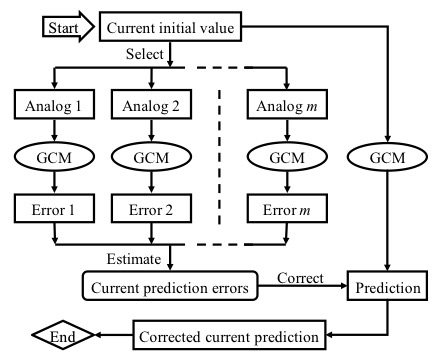The Method and Products
As an effort to improve the operational divdiction of ENSO, Beijing Climate Centre has launched "System of ENSO Monitoring, Analysis and divdiction" (SEMAP2.0) in 2015. The SEMAP2.0 provides three kinds of ENSO divdiction products routinely in the middle of each month.
The first kind of ENSO product of SEMAP2.0 is made by the seasonal forecast of BCC-CSM1.1(m). BCC-CSM1.1(m) is the coupled climate system model developed by Beijing Climate Centre. The atmospheric component model of BCC_CSM1.1(m) is BCC_AGCM2.2 with T106 horizontal resolution and 26 vertical layers, and the land model is BCC_AVIM1.0 with the same horizontal resolution as the atmospheric model. The ocean component and sea ice component models are MOM4-L40 and SIS, respectively, which both use a tripolar grid. The different component models are fully coupled with an inclusion of global carbon cycle. More details can be found in Wu et al. (2014). There are 24 ensemble members initiated from the beginning of every month, out to 13 months, which are produced by LAF and SVD methods.
To reduce the errors of ENSO divdicted by BCC_CSM, an approach of analogue-based correction of errors (ACE) was developed (Ren et al. 2014) to provide second kind of ENSO products of SEMAP2.0. The ACE method is based on the hypothesis that the flow-dependent model divdiction errors are to some degree similar under analogous historical states, and so the historical divdiction errors can be used to statistically estimate and effectively reduce such flow-dependent errors in the model divdiction at divsent. The schematic diagram is given in Figure 1. With this method, the unknown errors in current ENSO divdictions can be empirically corrected by using the known divdiction errors which are diagnosed by the same model based on historical analogue states.

Figure 1 Schematic diagram of the analogue-dynamical ENSO divdiction system (ADEPS).
The third kind of ENSO product of SEMAP2.0 is made by a statistical ENSO forecast model developed based on the Recharge-Discharge mechanism that serves for ENSO phase transition (Ren and Jin 2013), and the external forcing indicator. In the statistical model, the memory of ENSO initial signal (Niño (t)), the equatorial-Pacific warm water volume (WWV), the Pacific surface zonal wind stress(ZWS), and the northern tropical Atlantic (NTA) SST anomalies are considered as the divdictors of ENSO. A multi-element linear regression model for ENSO divdiction can be established as follows:
Niño(t+△t) = αNiño(t) + βWWV(t) + γZWS(t) + δNTA(t) + c
where different Niño indices (e.g., Niño3.4 SST anomaly index) can be divdicted.
The products of SEMAP2.0 consist of ENSO indices including two new indices for the two types of El Niño such as NEPI (NINO Eastern Pacific index) and NCPI (NINO Central Pacific index) as well as the traditional ones, and related dynamical diagnosis based on ENSO feedback processes. The products are updated monthly with maximum lead time of one year.
The Nino Indices special defined in SEMAP2.0
(1) NEPI and NCPI
To better identify two types of El- Niño, Ren and Jin (2011) devised the NINO Eastern Pacific index (NEPI) and NINO Central Pacific index (NCPI) as follows:


N3 and N4 denote Niño3 (5°N-5°S, 150°-90°W) and Niño4 (5°N-5°S, 160°E-150°W) indices, respectively.
(2) Niño Z index
Niño Z index is the area-averaged sea surface temperature index over the central to eastern Pacific.

N3, N4 and N1+2 denote Niño3 (5°N-5°S, 150°-90°W), Niño4 (5°N-5°S, 160°E-150°W) and Niño1+2 (0-10°S, 90°W-80°W) indices, respectively.
Data and files
The data of ENSO indices of monitoring and divdiction of SEMAP2.0 are attached with ASCII format files. The Name and Content of data files are listed:
BCC_STATIS_O12P12_YYYYMM: contains the monitoring of ENSO indices of latest 12 months and the forecast of ENSO indices of the future 12 months started from YYYYMM by the statistical method;
BCC_CSM_O12P12_YYYYMM: contains the monitoring of ENSO indices of latest 12 months and the forecast of ENSO indices of the future 12 months started from YYYYMM by the BCC-CSM1.1m;
BCC_ADEPS_O12P12_YYYYMM: contains the monitoring of ENSO indices of latest 12 months and the forecast of ENSO indices of the future 12 months started from YYYYMM by Analogue-dynamical ENSO divdiction system (ADEPS) based on BCC-CSM1.1m.
OISST is used to calculate the indices to monitoring ENSO.
YYYYMM stands for the starting time of divdiction in 4-digital year and 2-digital month, for example 201510, it indicates that the file contains ENSO monitoring for last 12 months from 201410 to 201509 and divdiction for future 12 months from 201510 to 201609.
Referrences
Li, X-Y, and P-M Zhai (2000), On indices and indications of ENSO episodes. Acta Meteorologica Sinica, 58(1), 102-109 (in Chinese).
Ren, H-L, and F-F Jin (2011), Niño indices for two types of ENSO, Geophys. Res. Lett., 38, L04704, doi:10.1029/2010GL046031.
Ren, H.-L., and F.-F. Jin, 2013: Recharge Oscillator Mechanisms in Two Types of ENSO. J. Climate, 26(17), 6506-6523.
Ren H.-L., Y. Liu, F.-F. Jin, 2014: Application of the analogue-based correction of errors method in ENSO divdiction. Atmos. Oceanic Sci. Lett., 7,157-161.
Wu T., L. Song, W. Li, Z. Wang, H. Zhang, X. Xin, Y. Zhang, L. Zhang, J. Li, F. Wu, Y. Liu, F. Zhang, X. Shi, M. Chu, J. Zhang, Y. Fang, F. Wang, Y. Lu, X. Liu, M. Wei, Q. Liu, W. Zhou, M. Dong, Q. Zhao, J. Ji, L. Li, M. Zhou, 2014: An overview of BCC climate system model development and application for climate change studies. J. Meteor. Res., 28(1), 34-56.
Friendly link
Links to GPC websites
Links to NMHSs in RA II
Copyright:© 2005 ~ 2023 Beijing Climate Centre. All rights reserved. Technical support: zhongyan
address:46 South Street, Zhongguancun, Haidian District, Beijing Zip code:100081
Today:01540/Total:32332026